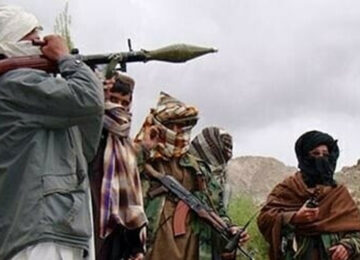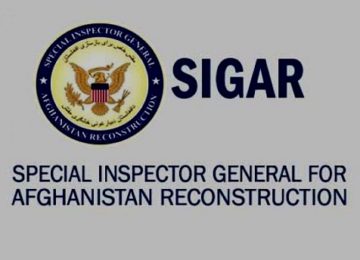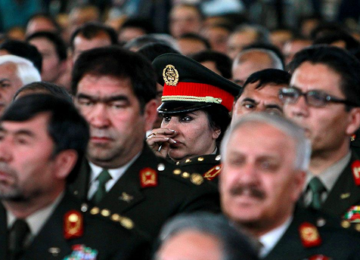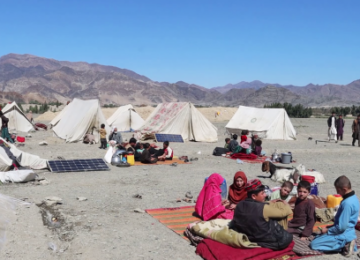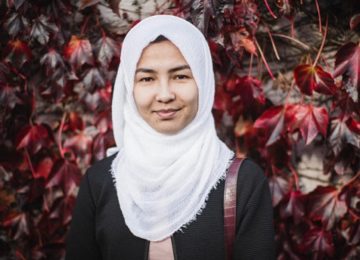US, Afghan Forces Need to Visit Sites, Obtain Witness Accounts.
The United States and Afghan governments are not adequately investigating possibly unlawful airstrikes in Afghanistan, which may contribute to rising civilian casualties, Human Rights Watch said today.
Recent accounts from airstrike victims and witnesses in Nangarhar and other Afghan provinces uncovered major failings in US and Afghan investigations of civilian deaths, injuries, and property damage – notably the unwillingness to interview witnesses and obtain other evidence on site.
“US and Afghan forces have an obligation to investigate possible laws-of-war violations when their airstrikes harm civilians,” said Patricia Gossman, senior Afghanistan researcher. “But unless you interview survivors and witnesses, you’re not going to get the full story. Inadequate investigations into civilian loss from airstrikes may violate the laws of war and deny victims justice and appropriate redress, which fosters distrust and resentment toward the Afghan and US governments.”
“But unless you interview survivors and witnesses, you’re not going to get the full story.”
Between November 2017 and April 2018, Human Rights Watch interviewed 42 civilian airstrike victims and witnesses in Nangarhar, Herat, and Kabul provinces. Human Rights Watch found that the Afghan government has developed almost no capacity to investigate civilian casualties arising from its military operations. Overall it has a poor track record conducting investigations into its own military. At the same time, US forces have downsized their civilian casualties tracking mechanisms and never conduct on-site investigations after attacks resulting in civilian casualties, relying instead on visual and satellite imagery and unreliable Afghan security force reports.
The United Nations Assistance Mission in Afghanistan (UNAMA) has reported that civilian casualties from US and Afghan airstrikes have increased since 2016 as air operations in Afghanistan have increased. In 2017, UNAMA documented 631 civilian casualties (295 deaths and 336 injuries) from 139 aerial operations conducted by Afghan government and US forces – a seven percent increase over 2016, and the highest yearly total of civilian casualties from airstrikes since systematic documentation began in 2009. Civilian casualties from air operations represent six percent of all civilian casualties from the conflict. Since 2015, attacks by insurgents have accounted for about 65 percent of all civilian casualties in the conflict.
Civilian casualty tracking in Afghanistan is currently conducted by the Afghan and US governments. Prior to the end of NATO’s combat mission in 2014, its Civilian Casualty Tracking Cell and Civilian Casualty Mitigation Team were responsible for tracking and investigating civilian casualty incidents, which contributed to some improvements in reporting and incorporating lessons learned to reduce civilian loss. NATO’s noncombat Resolute Support Mission has a significantly reduced civilian casualty team that that tracks incidents arising from both Resolute Support and the separate US combat mission.
The Afghan government took over basic tracking of casualties caused by its forces at the Presidential Information and Coordination Center, known as the Tawhid. The Tawhid collects information about civilian casualties, but does not conduct independent investigations. The Tawhid director told Human Rights Watch that it refers questions about a reported incident to the original reporting force – army, police, or air force. For some incidents, often high-profile, central or provincial authorities may order an investigation that involves other officials. These findings are not made public. The Afghan government provides a small payment to those injured, and to the families of those killed, in any conflict related incident.
US forces conduct only internal investigations into what they consider to be credible reports of civilian casualties. The Resolute Support civilian casualty team told Human Rights Watch that because of security concerns, the team never conducts site visits or speaks to witnesses or others on the ground, a practice similar to US military practice elsewhere. The team said it relies on evidence from video and still images, and on intelligence sources. It does not take into account information from outside sources, or sources considered to be pro-insurgent, a category that includes some Afghan government officials.
The failure to interview witnesses is a critical flaw in the Resolute Support civilian casualty investigation methodology because it excludes a key source of information, typically leaving investigators with only one side of the story. Witness statements are critical to any investigation when corroborated with other sources of information, such as site visits, physical evidence, photographic evidence, medical reports, hospital records, and other evidence. Resolute Support does not rely on any forensic or medical documentation not provided by its sources.
Under the laws of war applicable to the armed conflict in Afghanistan, warring parties must take constant care to spare the civilian population and civilian objects from the effects of hostilities. Parties are required to take precautionary measures with a view to avoiding, and in any event, minimizing, incidental loss of civilian life, injury to civilians, and damage to civilian objects. States have an obligation to investigate alleged serious violations of the laws of war and appropriately prosecute those responsible for war crimes. Civilians harmed by violations are entitled to prompt and appropriate compensation.
The Afghan government should improve its tracking and investigation procedures and ensure accountability for laws-of-war violations. The US government should robustly investigate incidents involving civilian casualties by seeking out evidence from a wider range of sources outside the US military, including witnesses.
“Our investigations of recent airstrikes killing dozens of Afghan civilians show that little real effort was made to uncover what happened,” Gossman said. “For these human tragedies to stop, the US and Afghan governments need to do more to fully investigate incidents and learn from them, and appropriately punish those responsible for unlawful civilian deaths.”
Failure to Investigate Civilian Casualties in Nangarhar Province
The border districts of Nangarhar province have seen intense fighting since 2016, as Afghan government forces operating with US air support have stepped up military operations in areas controlled by the insurgent Islamic State of Khorasan Province (ISKP, a branch of the Islamic State). The ISKP emerged in 2015 out of a loose affiliation of militant organizations driven out of Pakistan by military operations in 2009-2010. ISKP has exercised brutal control over these districts, extorting taxes, forcing schools and clinics to close, and summarily executing some who resisted. ISKP cells have carried out suicide bombings in Jalalabad, Kabul, and other cities, killing and injuring hundreds of civilians.
Since January 2017, US forces have carried out numerous air operations in eastern Nangarhar province. In December and February, Human Rights Watch interviewed residents from Nangarhar districts who said that some of these air operations killed and injured civilians. No findings of any US or Afghan investigations into these attacks have been made public.
Loi Papin, Haska Mena, Nangarhar
On August 10, 2017, a private vehicle traveling from the ISKP-controlled village of Loi Papin in Haska Mena district sustained serious damage, killing at least nine people and severely injuring one. The sole survivor, Rozina, 17, told Human Rights Watch that she and her family were fleeing the area because troop movements indicated that military operations were imminent:
We expected that Afghan or US forces would bomb by the next day. We drove for a few minutes and I saw a plane in the sky. There was a noise and I fell unconscious. When I woke, my father and brothers were dead. My aunt and cousins were injured and screaming, but I was hurt and couldn’t move. They died because no one came to help. I was there for hours before someone came.
A villager in the area carried Rozina from the wreckage. Her uncle Zafar Khan tried to reach the site but said the roads were blocked. After the district governor intervened, Zafar Khan and other relatives were allowed into the area for two hours to bury the bodies.
The next day, August 11, a Resolute Support spokesperson stated that US military forces had destroyed a vehicle “loaded with militants and munitions,” and that “the strike was conducted in the middle of open terrain. There was zero chance of civilian casualties.” In May, Resolute Support’s civilian casualty team told Human Rights Watch that the strike did not hit a civilian vehicle, but a militants’ vehicle seven kilometers away. The team said the civilian vehicle could have hit an improvised explosive device (IED).
Local and provincial officials reported the incident as an airstrike. A spokesperson for the Nangarhar provincial governor said that there had been an airstrike in the Haska Mina district that caused civilian casualties. An Afghan defense ministry spokesperson said the government had appointed a delegation to investigate the incident, but no findings were ever made public.
A photo purportedly showing the vehicle appeared in international media. A weapons expert told Human Rights Watch that it was not possible to determine from the single photo what had caused damage to the vehicle, which was blown over on its side.
Rozina received emergency medical care for injuries to her eyes and leg. It is not clear whether she or her relatives received the standard government payment of 50,000 Afs (US$705) per injury and 100,000 Afs (US$1,410) per death. As of April 2018, she needed further treatment not available in Nangarhar. “I am dependent on my brother now,” she said. “I am supposed to get married, but my in-laws think I cannot now. I have no hope for the future, but if I get treatment, I would have hope.”
Mariz, Haska Mena, Nangarhar
On the evening of July 22, 2017, Afghan armed forces launched a military operation against ISKP in Haska Mena district. A US airstrike on a funeral killed at least nine people. Nangarhar’s public health director confirmed that eight people, including six women, injured in the airstrike were bought to the hospital in Jalalabad.
Witnesses told Human Rights Watch that local residents had gathered for the funeral of a prominent tribal elder, Haji Aman Pacha.
S. Agha, whose mother, sister, and sister-in-law were killed in the airstrike, said:
There was a mourning ceremony and [people] were there to sympathize with the family.… My sister and mother were entering the guesthouse gate, and my sister-in-law was close by when the bomb hit. Their car is half buried in a ditch. The house was in between where there was fighting, about 200 meters in each direction. The airstrikes hit the guesthouse and the car.
S. Agha said the authorities had warned residents in nearby villages about the upcoming military operations, but not their village:
The government told the residents of Gorgora and Papin that they were going to launch an operation and they must leave. These people moved into our area temporarily, believing it would be safe. Most people could not afford to rent places in Jalalabad city. [Afterward] I argued with the Jalalabad police chief: “You warned people in Gorgora and Papin but not Mariz. If this area was secure, why did American forces launch a military operation here?” The police chief told me the American forces had launched the operation on their own.
In one media report, an Afghan official claimed that the man whose funeral it was had been an ISKP commander, and that ISKP members had gathered for the funeral. A district official stated that ISKP militants had fired at Afghan security forces from buildings near the funeral.
A US spokesperson confirmed the airstrike but said it was against armed insurgents, and that there were “no indications that civilians were in the area either before the strike or after the strike.”
S. Agha said that government officials had provided some assistance to the families of those killed and injured, and that President Ashraf Ghani had met with village residents after the incident and promised them additional assistance.
Human Rights Watch is unaware of any investigations into the attack or any findings being made public.
Pachir Agam, Nangarhar
In early January 2018, the Afghan armed forces carried out military operations in Pachir Agam and surrounding districts of Nangarhar province. On or around January 5, a private vehicle with at least eight civilian passengers, including men over age 60, women, and children, was traveling to attend a funeral for relatives killed in a drone strike in Karki when an Afghan attack helicopter strafed it. Three people were killed, including one woman, and at least five were injured.
Mohammad, 30, told Human Rights Watch that at 8 a.m. he had driven with his wife, their two children, Abida, 4, and Shakerullah, 2, and several other villagers to Karki. During the trip they heard a helicopter: “After that I can’t remember. We were in the back of the car and were thrown out.”
Bahadur Khan, 65, suffered severe injuries to his leg and pelvis:
The car was hit. There was a shhhhh sound – then I don’t remember after that. I was unconscious for three days. My hip bones were broken, and I’ve lost all feeling in one leg. I cannot walk unaided. I am ashamed that I cannot sit up. If I had died it would be better, but now I am disabled, and other people must help me do everything. I know I cannot recover.
Abdullah, 15, had both feet amputated:
I just saw the helicopter, then it happened. I don’t remember anything until I woke in the hospital. When I saw I had no feet – this was very hard. [A nongovernmental organization] promised to give me a wheelchair. If I were not disabled, I would support my family.
Hayat, 70, said:
Suddenly we heard a loud sound and people were thrown around – a woman in the seat behind the driver died. The driver and the man next to him were killed. There were four women and some children in the car. The villagers came and took the bodies and helped the injured people. I still feel burning pain in my hands. I lost a lot of my hearing. Why did it happen? Allah knows why. We were civilians – women and children. We don’t know why they kill us.
Human Rights Watch is unaware of any government investigation into the incident.
Mohammad said: “We went for a burial and got bombed. How can we ever go about normal life?”
Recommendations to the US and Afghan Governments on Investigations
- Adopt a policy of conducting on-site investigations whenever feasible, and of interviewing witnesses in all incidents involving credible allegations of civilian casualties. On-site investigations should include interviews with witnesses. If on-site investigations are not feasible, the US government should provide an explanation as to why it could not carry these out and explore ways for witnesses to meet with investigators or communicate by other means.
- Make public any explanation as to the US military’s assessment of the credibility of civilian casualty allegations and the standards used.
- Promptly release the findings of investigations, including conclusions, with as few redactions as possible. Set up a mechanism to communicate the results of investigations to civilian victims and their families.
- Findings should be the basis for developing lessons learned to minimize civilian harm in future operations and for bringing disciplinary or criminal cases against personnel responsible for violations of the rules of engagement or the laws of war.
- Provide prompt and adequate redress for civilian victims of laws-of-war violations. Ensure that there is a unified, comprehensive mechanism for providing ex gratia (“condolence”) payments to civilians who suffer losses due to military operations, regardless of the attack’s lawfulness. Consider non-monetary acknowledgements of the harm done, such as apologies.
- Periodically publish findings on civilian casualties from airstrikes, including the methodology used in such assessments for distinguishing between civilians and combatants. Continually review the methodology used with a view to improving the accuracy of the assessments.
- Encourage greater cooperation between the two governments to improve investigations of civilian casualties and take sufficient and consistent action to compensate and otherwise assist victims and their families.
This report was originally published by Human Rights Watch on May 16, 2018. Original link.
Disclaimer: Views expressed on this blog are not necessarily endorsed or supported by the Center for Research and Security Studies, Islamabad.




